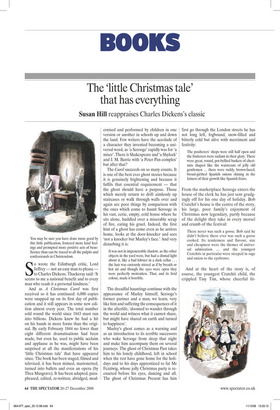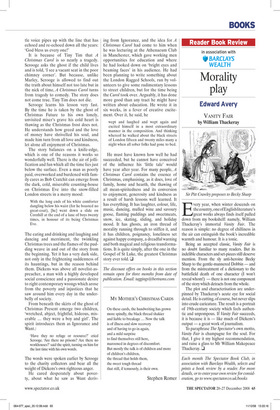The ‘little Christmas tale’ that has everything
Susan Hill reappraises Charles Dickens’s classic So wrote the Edinburgh critic, Lord Jeffrey — not an easy man to please — to Charles Dickens. Thackeray said: ‘It seems to me a national benefit and to every man who reads it a personal kindness.’ And as A Christmas Carol was first received so it has continued: 6,000 copies were snapped up on its first day of publication and it still appears in some new edition almost every year. The total number sold round the world since 1843 must run into billions. Dickens knew he had a hit on his hands in more forms than the original. By early February 1844 no fewer than eight different dramatisations had been made, but even he, used to public acclaim and applause as he was, might have been surprised at all the manifestations of his ‘little Christmas tale’ that have appeared since. The book has been staged, filmed and televised, it has been mimed, marionetted, turned into ballets and even an opera (by Thea Musgrave). It has been adapted, paraphrased, edited, re-written, abridged, mod ernised and performed by children in one version or another in schools up and down the land. Few writers have the accolade of a character they invented becoming a universal word, as ‘a Scrooge’ rapidly was for ‘a miser’. There is Shakespeare and ‘a Shylock’ and J. M. Barrie with ‘a Peter Pan complex’ but after that?
The Carol succeeds on so many counts. It is one of the best ever ghost stories because it is genuinely frightening and because it fulfils that essential requirement — that the ghost should have a purpose. Those which merely return to drift aimlessly up staircases or walk through walls over and again are poor things by comparison with the ones which come to haunt Scrooge in his vast, eerie, empty, cold house where he sits alone, huddled over a miserable scrap of fire, eating his gruel. Indeed, the first hint of a ghost has come even as he arrives home, looks at the door-knocker and sees ‘not a knocker but Marley’s face.’ And very disturbing it is:
It was not in impenetrable shadow, as the other objects in the yard were, but had a dismal light about it, like a bad lobster in a dark cellar . . . the hair was curiously stirred as if by breath or hot air and though the eyes were open they were perfectly motionless. That, and its livid colour, made it horrible.
The dreadful hauntings continue with the appearance of Marley himself, Scrooge’s former partner and a man, we learn, very like him and suffering the consequences of it in the afterlife, ‘doomed to wander through the world and witness what it cannot share, but might have shared on earth and turned to happiness’.
Marley’s ghost comes as a warning and as an introduction to its terrible successors who wake Scrooge from sleep that night and make him accompany them on several journeys. The ghost of Christmas Past takes him to his lonely childhood, left in school when the rest have gone home for the holidays and to his days apprenticed to fat Mr Fezziwig, whose jolly Christmas party is reenacted before his eyes, dancing and all. The ghost of Christmas Present has him first go through the London streets he has not long left, fogbound, snow-filled and bitterly cold but alive with merriment and festivity:
The poulterers’ shops were still half open and the fruiterers were radiant in their glory. There were great, round, pot-bellied baskets of chestnuts shaped like the waistcoats of jolly old gentlemen ... there were ruddy, brown-faced, broad-girthed Spanish onions shining in the fatness of their growth like Spanish friars.
From the marketplace Scrooge enters the house of the clerk he has just sent grudgingly off for his one day of holiday. Bob Cratchit’s house is the centre of the story, his large, poor family’s enjoyment of Christmas now legendary, partly because of the delight they take in every morsel and crumb of the festival:
There never was such a goose. Bob said he didn’t believe there ever was such a goose cooked. Its tenderness and flavour, size and cheapness were the themes of universal admiration ... and the youngest Cratchits in particular were steeped in sage and onion to the eyebrows.
And at the heart of the story is, of course, the youngest Cratchit child, the crippled Tiny Tim, whose cheerful lit tle voice pipes up with the line that has echoed and re-echoed down all the years: ‘God bless us every one!’ It is because of Tiny Tim that A Christmas Carol is so nearly a tragedy. Scrooge asks the ghost if the child lives and is told, ‘I see a vacant seat in the poor chimney corner’. But because, unlike Marley, Scrooge is allowed to find out the truth about himself not too late but in the nick of time, A Christmas Carol turns from tragedy to comedy. The story does not come true. Tiny Tim does not die.
Scrooge learns his lesson very fast. By the time he is taken by the ghost of Christmas Future to his own lonely, unvisited miser’s grave his cold heart is thawing as the Christmas frost does not. He understands how greed and the love of money have shrivelled his soul, and made him turn from all love and kindness, let alone all enjoyment of Christmas.
The story balances on a knife-edge, which is one of the reasons it works so wonderfully well. There is the air of jollification and fun which all the time lies just below the surface. Even a man as poorly paid, overworked and burdened with family cares as Bob Cratchit can emerge from the dark, cold, miserable counting-house on Christmas Eve into the snow-filled London streets in a merry mood:
With the long ends of his white comforter dangling below his waist (for he boasted no great-coat), [he] went down a slide on Cornhill at the end of a lane of boys twenty times, in honour of its being Christmas Eve.
The eating and drinking and laughing and dancing and merriment, the twinkling Christmas trees and the flames of the pudding weave in and out of the story from the beginning. Yet it has a very dark side, not only in the frightening suddenness of its hauntings, but in the reason behind them. Dickens was above all novelist-aspreacher, a man with a highly developed social conscience and a passionate desire to right contemporary wrongs which arose from the poverty and injustices that he saw around him every day in the underbelly of society.
From beneath the skirts of the ghost of Christmas Present emerge two children, ‘wretched, abject, frightful, hideous, miserable ... they were a boy and girl’. The spirit introduces them as Ignorance and Want.:
‘Have they no refuge or resource?’ cried Scrooge. ‘Are there no prisons? Are there no workhouses?’ said the spirit, turning on him for the last time with his own words.
The words were spoken earlier by Scrooge to the charity collectors and bear all the weight of Dickens’s own righteous anger.
He cared desperately about poverty, about what he saw as Want deriv ing from Ignorance, and the idea for A Christmas Carol had come to him when he was lecturing at the Athenaeum Club in Manchester, which gave working men opportunities for education and where he had looked down on ‘bright eyes and beaming faces’ in his audience. He had been planning to write something about the London Ragged Schools, run by volunteers to give some rudimentary lessons to street children, but for the time being the Carol took over. Arguably, it has done more good than any tract he might have written about education. He wrote it in six weeks, in a fever of creative excitement. Over it, he said, he
wept and laughed and wept again and excited himself in a most extraordinary manner in the composition. And thinking whereof he walked about the black streets of London fifteen and twenty miles many a night when all sober folks had gone to bed.
He must have known how well he had succeeded, but he cannot have conceived of the influence his ‘little tale’ would have year after year. For many people, A Christmas Carol contains the essence of Christmas, emphasising, as it does, love of family, home and hearth, the thawing of all mean-spiritedness and its conversion to enjoyment, generosity and kindness as a result of harsh lessons well learned. It has everything. It has laughter, colour, life, music, dancing, mulled wine and savoury goose, flaming puddings and sweetmeats, snow, ice, skating, sliding, and holiday mood. It has ghosts, an iron thread of morality running through to stiffen it, and it has children, poignancy, loneliness set against happy company, a dreadful warning and both magical and religious transformations. It is quite simply, after the one in the Gospel of St Luke, the greatest Christmas story ever told. ❑ The discount offers on books in this section remain open for three months from date of publication. Email: taggings@bertrams.com























































































































 Previous page
Previous page